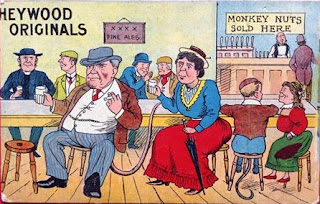Hey, Hey, We're Monkey Town
'It is with some diffidence that I venture to make an inquiry in relation to an offensive name which is sometimes derisively applied to Heywood. Is the origin of the name ‘Monkey Town,’ as given to Heywood, known? Is it known when the town was first slandered in this way?’
 |
Old Heywood postcard.
|
A well-known bit of self-effacing folklore still doing the rounds is that Heywood men used to have tails, and so the stools and benches in the town's pubs had holes in them for the tails to fit through. The reality, of course, is that the holes were there for carrying the stools.
There is no other known written record of the name before this time, so the best evidence merely tells us that the name was being used by the 1850s. It certainly was in an 1857 exchange between two letter-writers in a local newspaper. The first letter was titled ‘A Yewud (Heywood) Chap’s Visit to Bacup’, and signed ‘A Felley wi’ Slutchi Shoen un Breeches’ (a fellow with muddy shoes and breeches). He was a Heywood man and generally denigrated the muddy, hilly streets of Bacup in a light-hearted manner, and shortly afterwards a reply appeared, also written in the local dialect, headed ‘Obeawt that ‘Yewud Chap’s Visit to Bacup’. The writer referred to Heywood as ‘monkey-teawn’ three times in one paragraph.
So the name was being used in the 1850s, but who turned ‘Heap’ into ‘Ape’? Local accents are always changing over time, so we usually sound a bit different to our grandparents. Heywood people now say ‘Eep Bridge’, but our ancestors with their thicker accents (or people in nearby towns) might well have pronounced it as ‘Ape Bridge’. What is more obvious is the Irish inflection turning Heap into Ape. The fact that ‘Monkey Town’ wasn’t mentioned in print until the 1850s ties in with this. The Heywood-Bury stretch of the Lancashire and Yorkshire Railway line (now the East Lancashire Railway), which runs through Heap Bridge, opened in May 1848, and Irish navvies worked on the construction. This this happened at the height of the Great Famine, when a million people left Ireland and there was an influx of Irish refugees into Lancashire. It is quite probable that this is how the name came into being.
Also, while monkeys had been known in Britain as pets and performers since the 11th century, apes were still quite a new thing here in the 1850s. Although the British had known of the existence of great apes for a few centuries, by way of their African and Asian trading routes, the first one actually seen in Britain (that survived for any length of time) was a chimpanzee called Tommy, who was exhibited in London Zoo in 1835. He was quickly followed by an orangutan named Jenny. These zoo apes caused quite a small sensation at the time, so there would have been more public awareness of apes and what they were in the 1850s than there had been during previous centuries. This might also explain why the name ‘Ape Bridge’ suddenly became funny and understandable enough to be used as it was.
 |
| Jenny, the London Zoo orangutan, 1837 (ZSL). |
The nickname could not have been a flattering one. The human-like features of apes initially disturbed many people (including Queen Victoria), and they were emblematic of ‘discontent and discord’, almost as something that was pretending to be human. There were exceptionally racist connotations with apes, and the English had long depicted Africans and Irish people as having ape-like qualities. Despite the negativity associated with the name, over the years it was adopted by Heywoodites with self-deprecating humour (although, of course, Heywoodites had not been subjected to the destructive racism experienced by the Irish and African peoples).
It would seem that the unusual nickname ‘Monkey Town’ is derived from the pronunciation of Heap Bridge as ‘Ape’ Bridge, and probably dates from the 1840s-50s, not long after the arrival of apes in London and an influx of Irish people into Lancashire.
 |
| An old newspaper article about the strange nicknames of some British towns - including Heywood. |
- William Carew Hazlitt, English Proverbs and Proverbial Phrases, 1907.
- Edwin Waugh, Sketches of Lancashire Life, 1857.
- Bob Dobson, Lancashire Nicknames & Sayings, 1973.
- Geffrey Whitney, A Choice of Emblems, and Other Devices, For the most parte Gathered Out of Sundrie Writers, Englished and Moralized, and Divers Newly Devised, 1586.
- Hannah Haynes, Heywood, 1997.

Comments